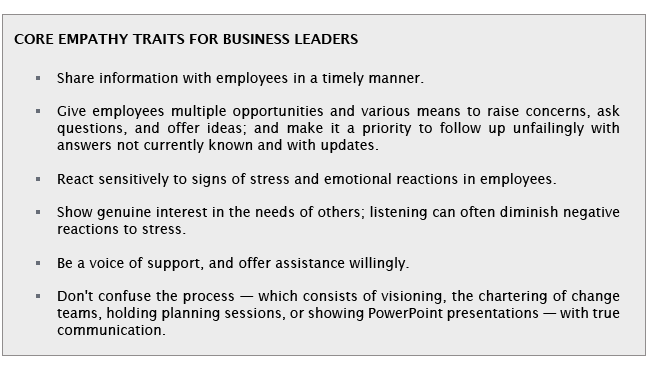
Imagine the following scenario: A large company in the midst of a turnaround has to close one of its businesses. The CEO calls the unit’s senior managers into his office. “Bad news,” he says. “We’re folding your business. We’ll be able to keep only about a third of the people, and the news won’t be public for a few weeks, so you have to keep operating as if everything’s normal until then.”
Stunned silence from the managers. “What about us?” one of them finally says.
“Still being decided,” the CEO replies, then turning to some papers on his desk to signal that the meeting is over. As the team files out, the CEO thinks to himself, 'Whew, it’s a relief to have that behind me. I’m sure the team appreciated that I was honest with them.' But as the managers return to their offices, they have an entirely different takeaway from the conversation.
For businesses in crisis, whether in a restructuring or taking steps to avoid one, the stakes cannot get any higher. In these situations, messages matter — not only their content but also their structure, the channel, the timing, and the tone they’re delivered in. What, when, and how executives communicate during a crisis are critical and can have a dramatic effect on the change process and resulting outcomes. We’ve developed a set of principles that business leaders can follow to communicate more effectively — and empathetically — during a crisis.
The Risks of Getting Crisis Communication Wrong
When a company is in deep trouble, the amount of time and attention it gives to its communications can unintentionally get minimized. An executive might quickly move past the issue of the importance of crafting the right message in the right tone and instead charge ahead, thinking that bad news is bad news and there’s no way to soften the blow. Such an approach can undermine an otherwise constructive resolution of the circumstance.
If leaders fail to communicate with empathy, a number of repercussions are likely.
- Morale often plummets when news of impending layoffs is communicated. Workers can become distracted and might divert their work time into efforts to understand how pending changes will affect them personally or their team. The organization’s culture can suddenly shift from one of collaboration to one of competition and dissent, where employees seek to protect their roles and responsibilities, start to form alliances, and stop openly communicating with colleagues.
- Engagement can drop. Uncoordinated messaging often causes a disconnect from the work and engenders an environment of apathy. Often, employees react to that ambiguity by creating stability on their own rather than remain in a state of insecurity. In extreme cases, they might begin actively searching for more-stable jobs that have future growth opportunities.
- Productivity can decline. When the future and direction of the business are unclear, levels of employee commitment wane. Change can elicit a range of emotions, and for many, those emotions can be fear driven.
Heavy-handed, poorly planned communications can quickly erode a company’s culture, which may then take years to repair. On a personal level, careless or incomplete communication can undermine leaders’ reputations and credibility and make it much harder to motivate and reengage the workforce after the crisis gets resolved.
Communicating Effectively in a Crisis
Many academic models have been developed for the management of change, but few deal with how leaders should communicate. (1.) Four principles, summarized with the CARE acronym, provide a foundation for effective communication in a crisis.
Chart a course: Map out the key events through the crisis. Where will stakeholders have questions? Where will the company need specific stakeholders to act or respond in a particular way to achieve a desired outcome? For each event, leaders will have to preemptively communicate clear and appropriate messages ahead of the event and then repeat those messages consistently during and after the event. In these situations, the more communication, the better. Regular meetings can also help—for example, by way of a monthly town hall meeting at which the CEO updates employees on the current state of progress against established goals, with local leaders providing more-interpersonal messaging and support.
Address the issues: Rather than avoiding or minimizing difficult topics and potential consequences, leaders should tackle the issues directly. Staff are usually more aware of underlying problems than management would like to believe, and downplaying issues can be counterproductive. It makes employees feel that the leaders aren’t honest, don’t trust the staff to handle sensitive news, don’t value staff input or contribution to the change effort, or are simply out of touch with reality.
Respect stakeholder needs: Each constituency has unique concerns and needs during a crisis. For example, employees may worry about job security or anticipated cuts to salaries or benefits. In extreme cases, they may wonder whether they’re going to receive their next paycheck. External stakeholders, like vendors, may be anxious about getting paid and their rights if or when the company files for bankruptcy. Customers may need reassurance that supply will not be disrupted. Government agencies, tax authorities, shareholders, and bondholders all have their own unique concerns as well. Good communication is a way to demonstrate both respect and reassurance to all stakeholders.
Empathize: Leaders should be human and remain calm, professional, and direct. All communications should be nonpersonal and respectful, which requires a combination of courage, candor, and compassion. Messages that connect leadership with the audience, that understand personal situations, and that address worries create the right environment for change and transition.
Why Does CARE Work?
The psychology of the CARE principles is well established. (2.) Communication is not a one-way process that is done to others. It must incorporate the audience’s perspective, their needs, and their voice to help shape the overall message and its meaning. In a context of change and crisis, leaders must serve as the guiding voice through the storm, must be able to articulate the current situation directly and without panic or alarm, and must be able to rally employees and teams so as to gain commitment and alignment for accomplishing the necessary tasks ahead.
Expressions of humanity, understanding, and patience are very effective communication tools for building trust, reassurance, and commitment among the workforce.

Pulling it Together
Applying the CARE principles through real-world actions requires commitment and a structured process. A core group of operational leaders and communications experts need to come together during the early, course-charting phase. This group will build a timeline that clarifies what the team members know and what they don’t know. The group will also identify key events in the restructuring process that require explanation, especially if the events need others to react in specific ways so as to achieve or accelerate a result.
For each key event identified, the leadership and the communication teams determine the specific message or messages, set the story line for each set of stakeholders and decide how to deliver the message to the right group at the right time and with the right level of detail—whether it’s in a letter, at a meeting, or through a formal or social media channel. The team will also have to designate who will deliver specific messages; specify the messages’ aspects those designees should and should not emphasize; and anticipate how to react to a variety of questions that may arise.
Last, if management historically has not been good at communicating, the team might want to start by educating company leaders about the value of good communications for each stakeholder audience and about ways of keeping the messages based in reality and focused on the future.
The bottom line? The way executives communicate during a crisis can have a major impact on how employees engage and how the company performs both during the crisis and afterward. It takes time to craft and then deliver clear, consistent communication and to make people feel heard and valued during what is invariably a stressful period for the executive teamand the entire company. But the rewards justify thoughtful efforts. Moreover, communicating empathetically is simply the right way to treat people.

Endnotes:
1. For example, Kotter’s Leading Change and Accelerate models address all aspects of change management. John P. Kottter, Leading Change, Boston: Harvard Business School Press, 2012.
2. Pamela Walaski, Risk and Crisis Communications: Methods and Messages, Hoboken, NJ: Wiley, 2011.